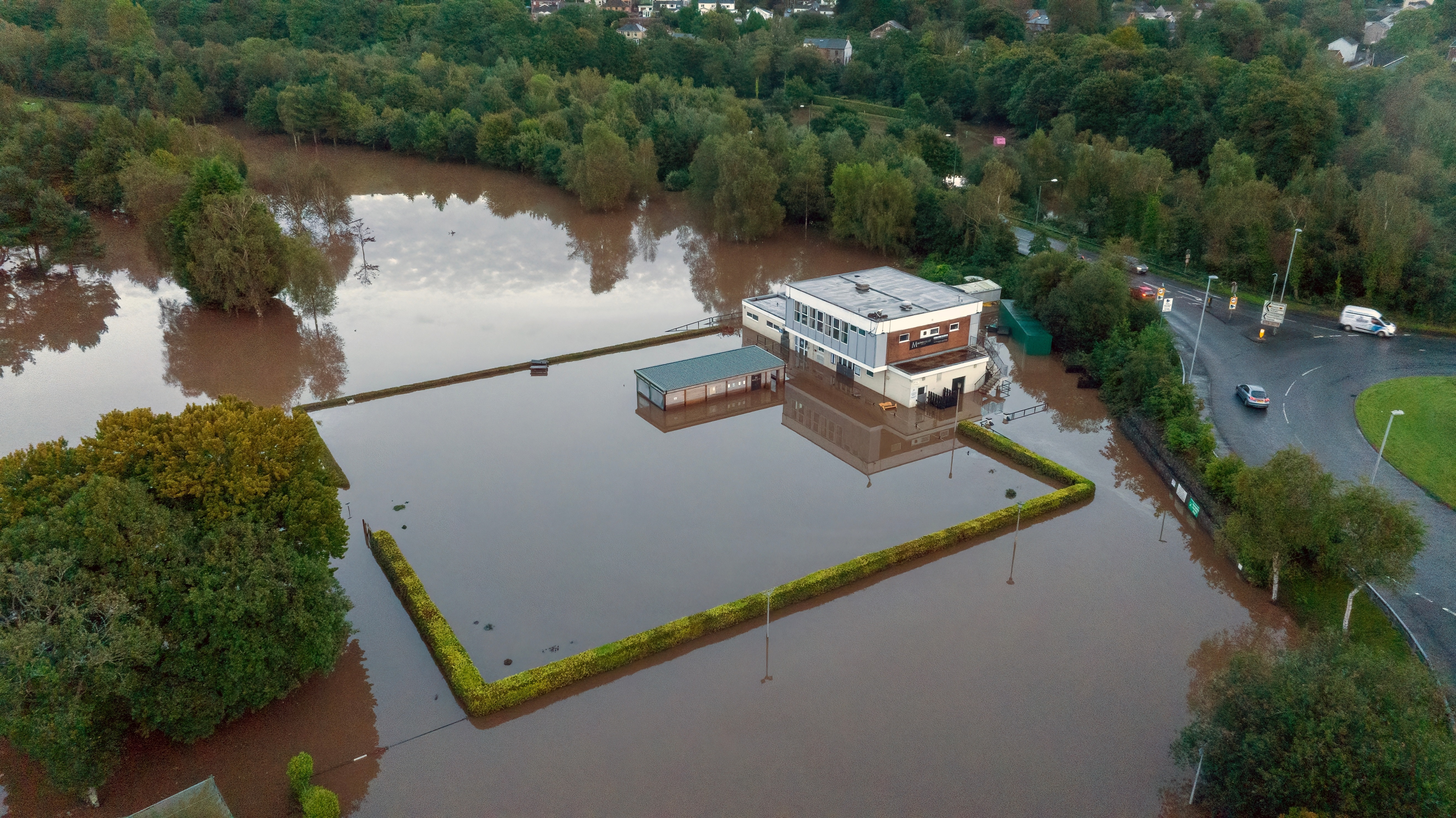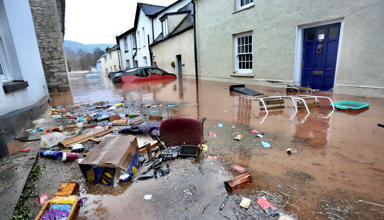Last winter, Storm Bert and Storm Darragh battered Wales, causing flooding, widespread power outages, and transport disruption.
The Senedd’s Climate Change, Environment, and Infrastructure (CCEI) Committee scrutinised public and private organisations’ response to these storms earlier this year. Its findings were published in September, and will be debated in the Senedd on 12 November.
Keeping pace with forecasting developments
Weather and flood warnings are vitally important to alert organisations and individuals of potential disruption. The inquiry heard many local authorities and residents had felt the forecasts and warnings ahead of Storm Bert had been inadequate.
The Met Office had issued a yellow rain warning, the lowest tier of warning, prior to Storm Bert. The inquiry heard that in Pontypridd no flood warning was issued until floodwater “was already over a foot deep in the streets”.
Severe weather and flood warnings are issued by three organisations – the Met Office, Flood Forecasting Centre (FFC), and Natural Resources Wales (NRW).
The FFC’s director said that flood forecasting services in Wales are diverging from England, where there’s more focus and investment on computational modelling in forecasts, longer lead times, and trialling forecasts for surface water flooding (forecasts currently only cover river flooding).
The Committee asked the Welsh Government to ensure that NRW has access to the latest forecasting technologies; that Wales can influence research and development priorities; and that NRW is able to participate in future forecasting trials.
The inquiry raised further concerns about forecasting in Wales, which are described in a separate Senedd Research article.
Inequalities in warning signups
NRW told the Committee flood warning signup levels “are not as high as we would want them to be”.
In a 2024 British Red Cross (BRC) survey, 36% of Welsh respondents said they weren’t signed up for flood warnings “because they did not know how to or had not heard of them”. The BRC found only 9% of the lowest income households across the UK were signed up for warnings, compared to 31% in the highest income areas.
The Committee asked for an update on what the Welsh Government and NRW are doing to promote awareness of warning systems among more vulnerable groups.
Problems identifying vulnerable people
Storm Darragh’s extreme winds caused severe damage to electricity distribution infrastructure. This was particularly true in west Wales, where thousands of households lost power.
Utilities companies maintain priority service registers (PSRs), which are meant to help them identify and deploy resources to vulnerable residents following service outages.
Local authorities criticised companies’ maintenance of PSRs – Carmarthenshire County Council said a register was inaccurate, out of date, and had to be vetted by council staff. Dŵr Cymru Welsh Water (DCWW) and SP Energy Networks representatives acknowledged the lack of data integration between organisations, and variable definitions of vulnerability.
The Cabinet Secretary for Climate Change and Rural Affairs, Huw Irranca-Davies MS, told the Committee the Welsh Government had developed the JIGSO system, which “enables access to information pertaining to vulnerable people in ‘at risk’ properties and is available to responders during a major incident.”
However, the Committee noted that “no other contributor to the Committee’s inquiry referred to this project”. It asked for clarity on the use and effectiveness of JIGSO, and whether it could replace the use of PSRs.
The importance of local communities
The Committee’s Citizen Engagement report found that many residents impacted by the storms had benefitted from local community support, which ranged from local farmers helping to evacuate households and clear debris, to neighbours providing lanterns.
The Committee echoed the National Infrastructure Commission for Wales’ (NICW) call for the Welsh Government to facilitate community-led resilience planning through the establishment of co-designed local flood plans, and community resilience groups.
Concerns about “ageing infrastructure”
A wide range of infrastructure was damaged during storms Bert and Darragh.
In Merthyr Tydfil, a 14m deep sinkhole opened up on a residential estate, caused by the collapse of a Victorian-era underground culvert. Almost a year later, the council has nearly finished its sinkhole remediation work at a cost of over £4m.
Rhondda Cynon Taf Borough Council told the Committee it incurred over £8m of damage during Storm Bert, despite investing over £100m on infrastructure improvements since 2020.
Powys County Council said its highway network is “not constructed or designed to modern-day standards”, whilst Blaenau Gwent County Borough Council said much of its infrastructure is “at the end of its design life” and is unable “to meet the resilience levels called for to meet climate change and the immediate, and growing storm incidents”.
Flooding in Clydach, Swansea, in 2023

Councillors spoke of the limitations of the Welsh Government’s Emergency Financial Assistance Scheme (EFAS), which partly refunds local authorities for repairs above a certain threshold. Some storm-related damage fell outside EFAS’s scope, and some local authorities felt the thresholds were too high.
Culverts – manmade underground water channels – were a particular concern. Often in private ownership and poor repair, culverts were frequently a focal point for damage after becoming inundated by storm-washed debris.
The Committee recommended reviewing EFAS thresholds, and that the Welsh Government updates and advertises its guidance for people responsible for storm-impacted water infrastructure, such as culverts.
Beyond concrete: catchment-scale and nature-based approaches
Traditionally, flood defence has focussed on solid, ‘grey’ infrastructure, such as drains, culverts, and floodwalls. Inquiry witnesses supported shifting towards longer-term, catchment-scale, and nature-based approaches to flood mitigation.
The Welsh Government currently publishes a 10-year Flood and Coastal Erosion Risk Management (FCERM) strategy, supported by annual funding allocations for specific projects. The Committee was sympathetic towards the NICW’s call to move towards a 30-year strategy, to facilitate “more ambitious and forward-looking investment decisions”.
The NICW also advocated a shift towards catchment-scale approaches to flood mitigation, as opposed to interventions restricted to single locations or at a local authority level. It cited positive examples in the Conwy valley and Usk catchment. NRW also supported more catchment-level focus, but raised the challenge of balancing short-term and long-term initiatives.
Natural flood management (NFM) uses natural processes to store water upstream of flood-prone areas, and slows the discharge of water into streams and rivers.
A DCWW spokesperson said planning rules can push developers “down a route of pouring concrete, which is a solution we do not want to do”. The Committee asked for reassurance that the existing NFM funding scheme would continue in future financial years, and that NFM methods are embedded into policy frameworks.
Building resilience for an uncertain future
One in seven Welsh homes is currently at risk of flooding, and a further 110,000 are predicted to be at risk by 2120 due to climate change. Last month, the UK Climate Change Committee recommended government adaptation plans need to account for more extreme climate scenarios by the middle of this century.
The CCEI Committee’s findings shine a light on the need to strengthen resilience in a rapidly changing world. In its response, the Welsh Government accepted most of the Committee’s recommendations.
You can watch the debate live on Senedd TV on 12 November.
Article by Dr Matthew Sutton, Senedd Research, Welsh Parliament






